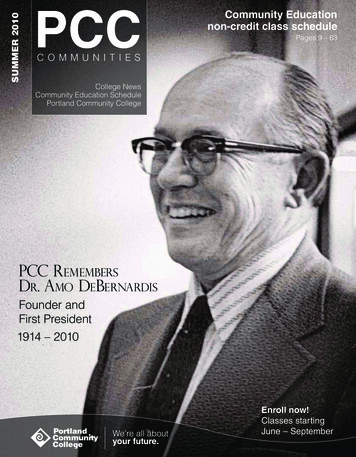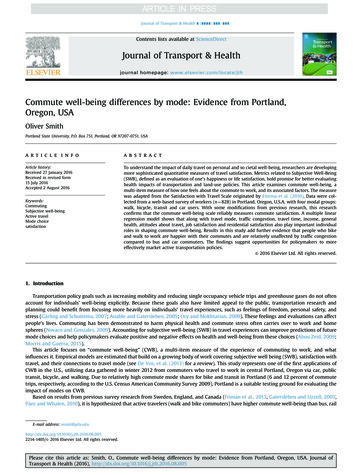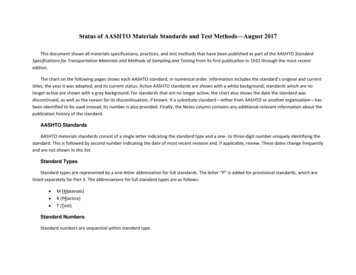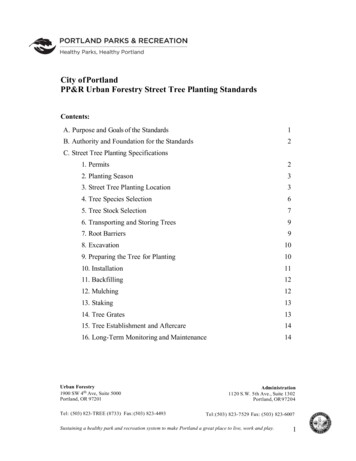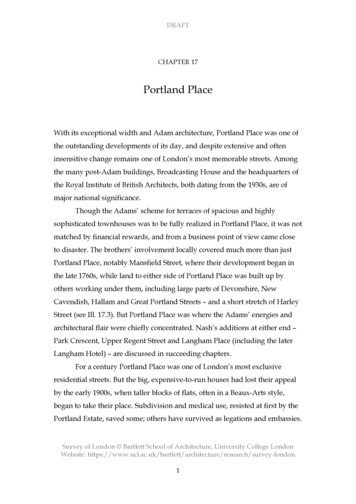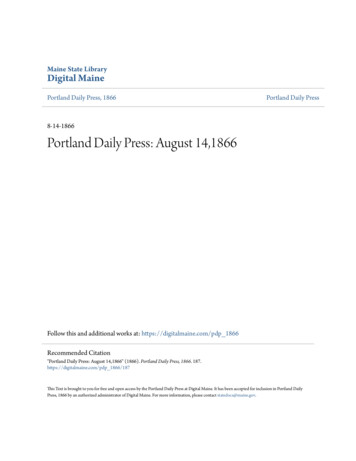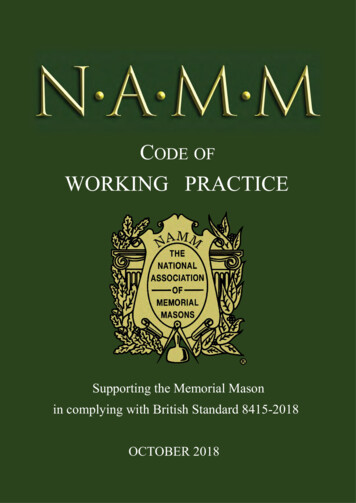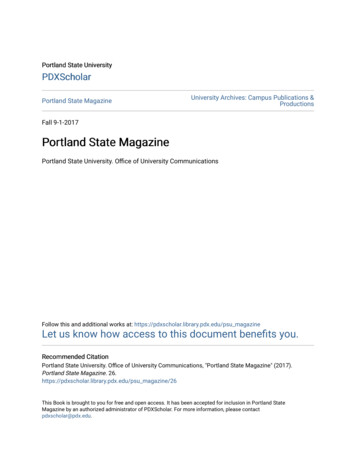
Transcription
Part IFinding YourLeverageClick Here to orderFrom Banishing Bureaucracy: The Five Strategies for Reinventing Government, by David Osborne and Peter Plastrik. 1997 byOsborne and Plastrik, and From The Reinventors’ Fieldbook, by David Osborne and Peter Plastrik. 2000 by Osborne and Plastrik
Chapter 1The Five C’s: ChangingGovernment’s DNAMargaret Thatcher:Discovering the Power of StrategyBy 1986, Margaret Thatcher was frustrated with her inability to move theBritish bureaucracy. For seven years, she had administered dose after doseof tough medicine: downsizing, privatization, efficiency audits, war with theunions. But she had failed to change the behavior of her civil service.Thatcher and her Conservative Party had come to power in the winter of1979, pledging to revive Great Britain’s slumping economy by reducing thesize of government, cutting spending, and slashing taxes. Gross domesticproduct (GDP) was in free fall. Inflation, at 10 percent, was accelerating.Public revenues were stagnating, public spending was rising, and publicservices were eroding. Government consumed 44 percent of GDP. Itowned huge portions of the economy: coal mines, the oil industry, the gasand electrical industries, auto companies, an airline, an aerospace firm, anddozens of other nationalized industries. (By comparison, government in theUnited States consumed about 35 percent of GDP at the time.)Thatcher’s instinct had been to slash away. At her first cabinet meeting,she announced a hiring freeze and a 3 percent cut in the civil service; several months later she imposed an additional 5 percent cut. On her fourthday in office, she asked Sir Derek Rayner, who ran the well-known retailfirm Marks & Spencer, to lead a crusade against waste and inefficiency.Rayner recruited six aides and launched a classic exercise favored by politicians determined to root out waste: efficiency audits of targeted programsClick Here to orderFrom Banishing Bureaucracy: The Five Strategies for Reinventing Government, by David Osborne and Peter Plastrik. 1997 by Osborne and Plastrik2
Part IFinding Your Leverage Chapter 1: The Five C’s: Changing Government’s DNAI /3and processes. Designed to streamline operations and eliminate waste, theybecame known as “efficiency scrutinies.”Under the watchful eye of Rayner’s Efficiency Unit, government departments conducted 223 scrutinies in the first three years. They led to the elimination of 12,000 positions and recurrent annual savings of 180 million. (Apound was worth 1.50 to 2.32, depending on the year.) They were effective in making specific changes, but, as leaders of the Efficiency Unit readily admitted when we talked with them, they did not lead organizations topursue continuous improvement. They helped weed the garden, patch bypatch, but they did not develop a regimen that kept the garden weed-free.Thatcher also took on the public sector unions, pushing through reformsthat outlawed secondary pickets, restricted union shops, and encouragedsecret ballots in union elections. In 1981 she stared down the civil serviceunions when they struck for five months. And in 1984 and 1985, she defeated the powerful mine workers union, which struck to keep the governmentfrom closing coal pits that were losing money.But Thatcher’s big weapon was privatization. In her 11 years, the government sold more than 40 major state-owned enterprises— including BritishPetroleum, Britoil, Jaguar, British Telecommunications, British Steel, BritishAirways, and Rolls-Royce—plus many smaller enterprises and more than 1.25million public housing units. By 1987 these sales were pulling in 5 billion ayear, helping Thatcher balance her last four budgets. (By 1994, the cumulative total was 75 billion.) “By the time I left office,” she later boasted, “thestate-owned sector of industry had been reduced by some 60 percent.Oversix hundred thousand jobs had passed from the public to the private sector.”Thatcher also clamped a spending lid on local government, most of whoserevenues came from the national level. In 1980 she required “compulsorycompetitive tendering”—competitive bidding between public and privateproviders—for all local building and highway construction. Two years latershe established an independent Audit Commission to oversee auditing oflocal governments and pressure them to increase their efficiency. And in1984 she imposed limits on local tax rates.These reforms not only forced local governments to change the way theydid business, they helped shrink the size of government. During Thatcher’sreign public employment fell from 30 to 24 percent of the workforce, dropping to its 1961 level, and government spending fell from 44 to 40.5 percentof GDP. Privatization not only reduced the size of government, it freed companies like British Airways to transform themselves into world leaders. But inthe core civil service—the non-enterprise, non-health-care departmentswhere 600,000 civil servants still labored—performance changed very little.Click Here to orderFrom Banishing Bureaucracy: The Five Strategies for Reinventing Government, by David Osborne and Peter Plastrik. 1997 by Osborne and Plastrik
Part IFinding Your Leverage Chapter 1: The Five C’s: Changing Government’s DNAI/4In short, jamming the bureaucracy was not getting the prime ministerwhere she wanted to go. When she privatized an enterprise or cut a budgetor launched an efficiency scrutiny, nothing changed in other departments.No other dominoes fell. She needed a strategy beyond privatization and efficiency scrutinies.The Next Steps: Uncoupling Steering and RowingWhen Thatcher and her colleagues entered office, they held most publicemployees in contempt. They threw around slogans like “Deprivilege theCivil Service.” But as Thatcher worked with administrators who impressedher, her attitude changed. “She found herself confronted with civil servantswho were entrepreneurial,” says Michael Clarke, head of the University ofBirmingham’s School of Public Policy. “She encouraged and promoted arange of those people—she had an eye for ‘can do’ civil servants.” In fact,Thatcher triggered a revolt in her own party in 1985 by raising salaries for topcivil servants by as much as 50 percent.Thatcher also began to learn more about the systemic problems behindgovernment’s waste and inefficiency. In 1982, the Efficiency Unit and one ofher ministers, Michael Heseltine, convinced her to launch a new management initiative. Upon taking office, Heseltine had discovered that his department had no adequate financial management system, so he had set about creating one. He and his civil servants had built a system that set objectives foreach unit, defined their budgets, and measured both their spending andprogress toward objectives.Thatcher, Rayner, and the Treasury Department took the idea government-wide. Their Financial Management Initiative required departments toset performance objectives for all managers: what they expected to achieve,by when, and at what cost. It broke departmental budgets down and madeeach unit responsible for managing its own funds. It required new management information systems that could give managers reliable data on the costsof their activities. All this was held together by a “top management system,”through which departments prepared annual statements summarizing theperformance and plans of their units. Ministers, top management, and unitmanagers would review these and agree on action plans.Thatcher invested considerable sums in the computer systems necessaryto run the Financial Management Initiative. The government built up morethan 1,800 performance objectives, most of them focused on cost and efficiency. But the impact of the new system was disappointing; it had littleeffect on the behavior of the civil service. It created valuable information, butit did not change the fundamental dynamics of government organizations. InClick Here to orderFrom Banishing Bureaucracy: The Five Strategies for Reinventing Government, by David Osborne and Peter Plastrik. 1997 by Osborne and Plastrik
Part IFinding Your Leverage Chapter 1: The Five C’s: Changing Government’s DNAI /51986 Thatcher asked Rayner’s successor, Sir Robin Ibbs, to assess the initiative and recommend the next steps.By now the Efficiency Unit had six years of experience under its belt. Itsmembers—drawn from both business and government—had learned a greatdeal about the realities of management in the public sector. They had longsince lost interest in knee-jerk solutions.In the previous 150 years, prime ministers had commissioned many blueribbon inquiries into the problems of public management. But not one hadasked the bureaucrats what they thought. The Efficiency Unit did just that.Over three months, its members interviewed hundreds of civil servants, aswell as businesspeople and experts on public management.They found—indeed, they no doubt already knew—that the time-honoredBritish system of public administration made good management almostimpossible. Senior civil servants were not trained for management and did notcare about management. The elite members of the civil service advised ministers on the great policy issues of the day. They did not stoop to get theirhands dirty with implementation, and they looked down on managers—whodid—as second-class civil servants. They took their marching orders fromelected ministers, who were consumed by politics and policy. Like cabinetsecretaries in any large nation, few ministers even saw management as theirjob. As Rayner once put it, “leadership has too often in the past fallen into thehands of those who know nothing of management and despise those who do.”Managers were so far down the civil service pecking order that they hadlittle real control over what they were supposed to manage. Power was centralized at the top of the departments and in the Treasury Department,which combined the powers of a central office of management and budget,a central personnel office, and an American-style Treasury Department.The results of the system were predictable. The Efficiency Unit reportdescribed a shortage of good managers; little top-level focus on the deliveryof public services; a budget and finance system focused more on controllingspending than on making it effective; and few external pressures on government managers and organizations to improve performance.In addition, the Efficiency Unit pointed out, the civil service was “too bigand diverse to manage as a single entity.” “Recruitment, dismissal, choice ofstaff, promotion, pay, hours of work, accommodation, grading, organizationof work, the use of IT [information technology] equipment are all outside thecontrol of most civil service managers at all levels,” it said. The civil servicerule book was “structured to fit everything in general and nothing in particular.” Managers viewed the personnel system as a huge constraint on goodmanagement—but a constraint that was impossible to change.Click Here to orderFrom Banishing Bureaucracy: The Five Strategies for Reinventing Government, by David Osborne and Peter Plastrik. 1997 by Osborne and Plastrik
Part IFinding Your Leverage Chapter 1: The Five C’s: Changing Government’s DNAI/6In sum, the Efficiency Unit concluded, the civil servants were not theproblem; the systems were. Ibbs had not intended to recommend radicalreform, but it was clear that the systems and structure of the bureaucracywould have to change if effective management were to become a priority.The unit’s 1988 report, “Improving Management in Government: TheNext Steps,” argued that to solve the management problem, the governmentwould have to separate service-delivery and compliance functions from thepolicy-focused departments that housed them—to separate steering fromrowing. Second, it would have to give service-delivery and compliance agencies much more flexibility and autonomy. And third, it would have to holdthose agencies accountable for results, through performance contracts.The Efficiency Unit proposed, in other words, an arm’s-length performance contract between departments and their agencies, in which departments traded the freedom agencies needed to manage effectively for the performance standards ministers needed to hold them accountable. Ibbs and hisstaff envisioned a civil service with a small core at the center supporting ministers, doing policy work, and managing departments, while the bulk of civilservants worked in relatively independent agencies.Now in her ninth year as prime minister, Margaret Thatcher stepped upto the challenge. She accepted all of the unit’s recommendations— includingits urging that an “extremely” senior official be appointed project managerand given “unequivocal personal responsibility for achieving the change.”She appointed Peter Kemp, a senior Treasury official who had come into thecivil service from the private sector and was known as a maverick, to overseethe Next Steps program. Kemp staffed his team with bright, young, highlevel civil servants on loan from their departments. They fleshed out the NextSteps proposals, developing a process that would: separate departments’ service-delivery and compliance functions intodiscrete chunks, each one called an “executive agency”; give those agencies much more control over their budgets, personnelsystems, and other management practices; use a competitive public-private sector search—a radical break with civilservice practice—to find chief executives for executive agencies; require chief executives to develop three-to-five-year corporate plansand one-year business plans;Click Here to orderFrom Banishing Bureaucracy: The Five Strategies for Reinventing Government, by David Osborne and Peter Plastrik. 1997 by Osborne and Plastrik
Part IFinding Your Leverage Chapter 1: The Five C’s: Changing Government’s DNAI /7 negotiate a three-year “framework document” between each agency andits departmental minister, specifying the results it would achieve and theflexibilities with which it would operate; pay chief executives whatever it took to get the talent needed, includingperformance bonuses of up to 20 percent of their salaries; deny chief executives the civil service’s normal lifetime tenure; and require them to reapply for their jobs every three years.Kemp quickly signaled the importance of Next Steps and captured theimaginations of reformers by announcing that his target was to move 75 percent of the civil service into executive agencies. The Treasury asked alldepartments to review their functions and decide upon one of five optionsfor each: abolition, sale, contracting out, conversion to executive-agency status, or preservation with no change. Once a functional area within a department had been nominated for agency status, it was referred to a project executive team, whose members included representatives from the department,Kemp’s staff, and the Treasury. They negotiated framework documents outlining the flexibilities granted the agency and the outputs expected. TheTreasury acted as a gatekeeper, refusing to approve agency status until it wassatisfied that true performance accountability was in place.Kemp and his Next Steps team hit the ground running. Deliberately starting with organizations that were ready for agency status, they created eightagencies in the first year, 1988-1989. By early 1991 they had established 51agencies, a pace that surprised most observers. By mid-1992 half the civilservice worked in executive agencies, and by late 1996 the process was all butcomplete: nearly 75 percent of the civil service worked in 126 agencies. (The75 percent figure includes 50 executive offices within two large departments,Inland Revenue and Customs and Excise, that operate along Next Steps linesbut are not technically described as executive agencies.)Finding the Leverage PointsThere are many lessons to be learned from the British experience. It shows,for example, that reinvention requires collaboration between elected officialsand civil servants—between what we call the political and institutional sectors. There were many things the civil servants would never have done ontheir own, and there were an equal number of things the politicians wouldnever have seen on their own. Both sides had their blind spots.Click Here to orderFrom Banishing Bureaucracy: The Five Strategies for Reinventing Government, by David Osborne and Peter Plastrik. 1997 by Osborne and Plastrik
Part IFinding Your Leverage Chapter 1: The Five C’s: Changing Government’s DNAI/8More important for this book, however, is the lesson the British learnedabout strategy. Margaret Thatcher could not succeed on instinct alone. Herfirst attempts to reform the civil service bureaucracy—staff cuts and efficiency scrutinies—were inadequate. They did not create a domino effect,forcing everything else to change. In a word, they were not strategic. It wasnot until her Efficiency Unit developed strategies capable of creating thatdomino effect that she began to make headway.By strategy, we do not mean detailed plans. There is no recipe you can follow to reinvent government, no step-by-step progression you must adhere to.Many writers and consultants discuss organizational change in terms of“stages” that they put into a neat, linear order. But the process is not linear,and it is certainly not orderly. Things rarely go as planned; reinventors mustconstantly adjust their approaches in response to the resistance and opportunities they encounter.By strategy, we mean the use of key leverage points to make fundamentalchanges that ripple throughout government, changing everything else.Reinvention is large-scale combat. It requires intense, prolonged struggle inthe political arena, in the institutions of government, and in the communityand society. Given the enormity of the task and the resistance that must beovercome, the reinventors’ challenge— whether in the U.K., the U.S., orelsewhere—is to leverage small resources into big changes. Being strategicmeans using the levers available to you to change the underlying dynamics ina system, in a way that changes everyone’s behavior.The word “strategy” originated in a military context: the Greek strategosmeans “general.” Good generals begin by developing strategies: not operational plans, but basic approaches capable of altering the balance of forces inthe field. When the U.S. chose to force Iraq out of Kuwait in 1991, its generals decided their leverage was twofold: massive bombardment to blind anddebilitate the enemy, then quick, stealthy movement of divisions to create apincer-like ground attack. These two strategies set the stage for day-to-dayoperational tactics, which guided the use of tools such as jets and tanks.Margaret Thatcher and her advisors did something similar. They locatedtheir government’s key leverage points and used them to change the balanceof forces—to alter the basic dynamics within the public sector. The NextSteps process changed three leverage points: it uncoupled rowing organizations from steering organizations, so each could focus on its primary mission;it gave rowing organizations control over most of their own decisions, so theycould make the changes necessary to improve their operations; and it created consequences for their performance, so they would have incentives toimprove.Click Here to orderFrom Banishing Bureaucracy: The Five Strategies for Reinventing Government, by David Osborne and Peter Plastrik. 1997 by Osborne and Plastrik
Part IFinding Your Leverage Chapter 1: The Five C’s: Changing Government’s DNAI /9These new dynamics unleashed tremendous changes within many agencies. The basic tasks of writing the framework document, corporate plan, andbusiness plan quickly forced into the open many of the problems that had tobe dealt with. They forced agencies to define their missions, objectives, andperformance targets. “Before Next Steps,” explains Treasury official MarkPerfect, “the Department of Transport could say convincingly that it was fartoo complicated to define outputs for all of what it did. The agencies can’t saythat.”Agencies improved at varying speeds—some rapidly, some slowly. Butoverall, they managed to hit 75 percent of their performance targets in theearly years. They have gradually raised many of these targets, but by 1995they were hitting 83 percent. To improve their performance, agencies haveused almost every tool in the reinventor’s kit: contracting out, public versusprivate competition, accrual accounting, performance bonuses, group bonuses, total quality management, customer surveys, business process reengineering, internal markets, marketing to new customers, credit card payments, “one-stop” offices, and on and on.The Vehicle Inspectorate, the first agency created under Next Steps,quickly opened offices on Saturdays and Sundays, for example. It introduceda series of new services, contracted out some old ones, removed a layer ofmanagement, and established group performance bonuses keyed to overallefficiency increases. In its first three years it reported operating cost efficiency increases of 4.5, 4.1, and 3.6 percent—triggering bonuses of up to 213 per employee. (Operating costs in the U.K. are known as “runningcosts”; they include all payroll, overhead, rent, and other operating expenses,but not direct program costs such as benefits paid to customers.)The Information Technology Services Agency in the Department of SocialSecurity set up customer account managers for all its customers, developedservice agreements spelling out what it would deliver at what price, launchedannual customer surveys, and contracted with private firms to supply virtually all of its information technology services. In its first five years it reportedrunning cost efficiency increases of 5.5, 4.5, 16.2, 30, and 17.4 percent.The Employment Service, one of the largest executive agencies, beganmeasuring performance and publishing comparative data about each of itsnine regions, to force improvement. Later it pushed the comparisons downto the local office level; each now displays its performance record and therecords of up to six neighboring offices. At the same time, Chief ExecutiveMichael Fogden gave his regions great flexibility. Many have cut waitingtimes dramatically. Most have changed the look and layout of their offices,putting in carpeting, bringing in plants, having employees wear name tags,Click Here to orderFrom Banishing Bureaucracy: The Five Strategies for Reinventing Government, by David Osborne and Peter Plastrik. 1997 by Osborne and Plastrik
Part IFinding Your Leverage Chapter 1: The Five C’s: Changing Government’s DNAI/10and getting rid of glass barriers. The entire agency has eliminated a layer ofmanagement and restructured its personnel system, including pay, grading,and recruitment. Fogden has instituted regular customer surveys, customerpanels, and customer service standards. The surveys show general improvement, while other indicators show a 40 percent increase in job placementswith no new resources, gradual improvements in the accuracy of benefit payments, and 2 percent annual increases in running cost efficiency.Some departments were reluctant to give the agencies the freedom theyneeded to maximize performance, according to a 1994 review of the agencyprocess. This created a tug-of-war between departments and agencies. Butthe agencies’ record of achievement gradually convinced the TreasuryDepartment to give them enormous flexibility on budget and personnel matters, which resolved their most pressing problems. Once convinced thatagencies would not overspend their budgets, Treasury gave them (and allgovernment departments) control over their own budgets, pay structures,bargaining, and personnel grading systems for all but the most senior civilservants. It consolidated a stack of thick volumes into one book of essentialpersonnel rules.Treasury also allowed agencies to carry over any unspent funds into thenext year. The trade-off was a four-year spending freeze on running costs,requiring agencies to generate any pay increases or inflation adjustments outof their own savings—their “efficiency dividend.” In 1994-1995, the 80-plusagencies in existence decreased their running costs by an average of 4.7 percent. The fiscal squeeze contributed to a 15 percent reduction in the size ofthe civil service between 1988 and 1996.Overall, Next Steps is widely viewed as a resounding success. InNovember 1994, Parliament’s Treasury and Civil Service Committee called it“the single most successful Civil Service reform programme of recentdecades.” The unions have not opposed it, and as early as 1991 the LaborParty announced it would keep Next Steps in place if it won power.Market Testing:Increasing the Consequences for PerformanceWhile pleased with the initial improvements the Next Steps agencies offered,Thatcher and her advisors wanted more. They had watched privatization produce sudden, quantum leaps in productivity. Their initial experiments withcompetitive contracting, at both the national and local levels, had also yielded large savings. They wanted to inject the sense of urgency created by privatization and competition into the agencies—an urgency far greater thanthey could achieve with performance contracts and bonuses. They decidedClick Here to orderFrom Banishing Bureaucracy: The Five Strategies for Reinventing Government, by David Osborne and Peter Plastrik. 1997 by Osborne and Plastrik
Part IFinding Your Leverage Chapter 1: The Five C’s: Changing Government’s DNAI /11they needed a new strategy.The result was a white paper called “Competing for Quality.” Actuallypublished in 1991, after John Major succeeded Thatcher as prime minister,it announced a series of decisions to inject more competition into public service delivery. First, it required that agencies be reviewed every time theirframework documents expired. Every three years (now every five years),departments put agencies on trial for their lives. Using what they call a “prioroptions review,” they examine each agency’s function and performance to seeif the entire agency or pieces of it should be abolished or sold. If they decideto keep an agency alive, the department tells it how much of its work it mustcompetitively bid—a process called “market testing.” The agency can ask forprivate sector bids only, or it can let its units bid against private companiesfor the work.The white paper actually covered all government activities, not just executive agencies. It ordered local governments to competitively bid (public versus private) many white-collar services. (In 1988 Thatcher had required themto competitively bid more blue-collar services.) It required departments tobring in private sector help in analyzing the most promising areas for privatization and contracting, and it gave them an incentive to privatize by allowing them to keep any savings achieved. It offered no job guarantees to civilservants, effectively ending their job-for-life tenure. It did, however, promisethat if agencies lost work, “every effort will be made to deploy staff elsewherewithin the department. The contractor will be encouraged to re-employ staff.”Within the first five years, prior options reviews resulted in decisions toprivatize more than a dozen executive agencies. In September 1995, the government reported that it had also conducted hundreds of market tests, covering 2.6 billion of services (about 4.3 billion) and resulting in annual savings of more than 500 million (about 815 million).The pressure of competition has driven rapid change inside public organizations. Where public and private providers have competed head-to-head,public providers have won twice as many contracts (although the private sector has won larger contracts, on average). Regardless of who wins, savings areaveraging 21 percent.The Citizen’s Charter: Making the Customer PowerfulEven their advocates admit that while Next Steps and market testing created internal management improvements and heightened efficiency, they didmuch less to improve effectiveness—the quality of public services. Thesestrategies pushed agencies to improve their performance in the eyes of thegovernment, and the Conservative government was obsessed with efficiency.Click Here to orderFrom Banishing Bureaucracy: The Five Strategies for Reinventing Government, by David Osborne and Peter Plastrik. 1997 by Osborne and Plastrik
Part IFinding Your Leverage Chapter 1: The Five C’s: Changing Government’s DNAI/12But the public cared about far more than efficiency. Citizens wanted publicservices to be effective: they wanted the subways and commuter trains to runon time, the mail to arrive in one day, and their children to receive a qualityeducation.To force agencies to look beyond efficiency—to produce quality servicesfor their customers—the government needed a new strategy. It needed tomake agencies directly accountable to their customers. The answer was JohnMajor’s favorite reform, the Citizen’s Charter.Major was the rare Conservative leader who had grown up working-class,experiencing firsthand the shoddy quality of public services. As one aide putit, he knew too well the attitude of many local councils toward citizens: “Weknow what you want, and this is what you’re going to get, and you’re going tolike it.”Major launched his new strategy in July 1991. It was a typical political initiative, rushed out by a politician intent on making a point with the electoratebefore the next election, which was a year away. Diana Goldsworthy, a NextSteps team member who became deputy director of the Citizen’s Charterunit, tells the story:The Charter was launched precisely at the point when managers neededto do something about the question of quality. As we set these agencies up,they started talking about “customers” and “customer service.” To startwith we used the words very loosely. Then people began to say, “Well,what is in it for the customer?
reign public employment fell from 30 to 24 percent of the workforce, drop-ping to its 1961 level, and government spending fell from 44 to 40.5 percent of GDP. Privatization not only reduced the size of government, it freed com- . care about management. The elite members of the civil service advised min-isters on the great policy issues of the .
